Hidden behind high walls, the Charterhouse in Clerkenwell exudes an air of mystery – at least to those who, like me, spend their lunchbreaks wandering around the interesting old places close to their place of work. The Charterhouse is only open to the public for pre-booked guided tours, but a few weeks ago I was fortunate enough to be able to visit the Charterhouse to attend a wonderful lecture about the history of the site by the Charterhouse’s head archivist, Dr Stephen Porter.

The lecture was held in the beautiful upstairs room known as the Great Chamber, which had a grand fireplace and old, faded tapestries hanging on the wall. Dr Porter’s lecture was utterly enthralling – it was a real pleasure to listen to a history of the Charterhouse given by someone who clearly lives and breathes this fascinating old building. I knew little about the Charterhouse other than the basics, and found Dr Porter’s lecture – particularly when he talked about the fortunes of the building in the 1940s and 1950s – utterly fascinating.
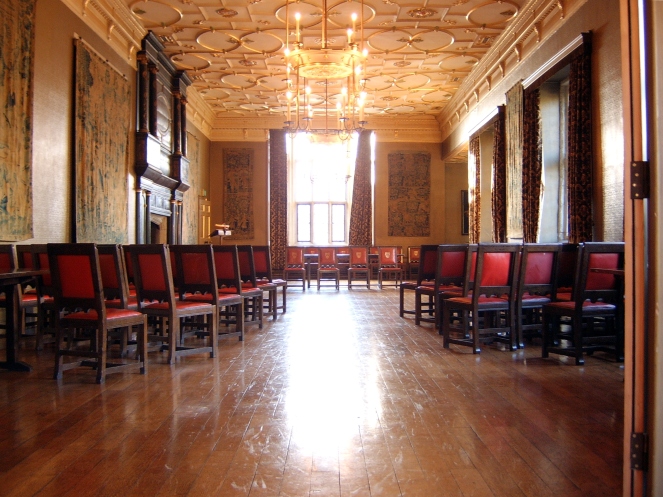
The Duke of Norfolk had, whilst under house arrest, extended the very room the lecture was being held in, but to tell the Duke’s story would be jumping the gun somewhat, so let’s go back to the beginning of the Charterhouse’s story.
When the terrible bubonic plague known as the Black Death swept through Europe in the late 1340s, London found itself faced with a huge number of bodies to bury. For this purpose, land north of St Bartholomew’s hospital was purchased and used as a burial ground for the unfortunate victims of the plague. After many years of knowing that such a site existed in the Charterhouse area but with no concrete proof of its existence, archaeologists working on the site of the new Crossrail project in 2013 discovered burials from the 14th Century. Perhaps surprisingly – and unlike the huge plague pit uncovered near the Tower of London at East Smithfield – the burials were in individual graves rather than huge mass burial trenches. This discovery has allowed researchers to learn more about the nature of the plague, and has also provided a fascinating insight into Londoners in the 14th Century – tests found that, much like today, people moved to London from all over the British Isles.
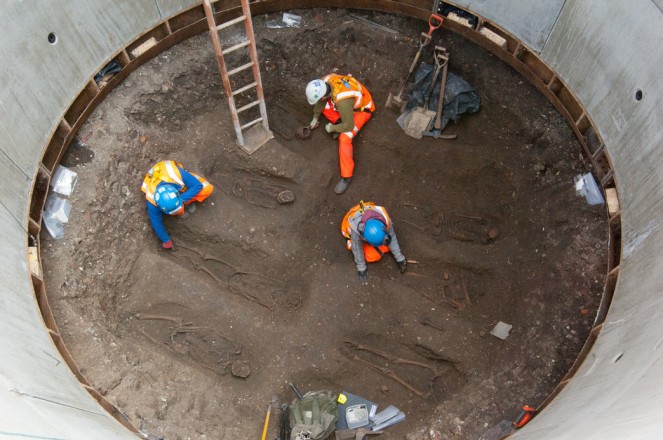
London was blighted by plague again in 1461, and it was a few years after this second outbreak that the Charterhouse Priory was founded to the north of the plague burial ground. The priory consisted of twenty-four Carthusian monks and a prior. The Carthusian order, founded in the 11th Century, followed strict rules and the monks spent most of their time in silence and solitude. Each of the monks had his own cell, a little two-storey building where he spent the majority of his time praying and studying. This led to the Carthusians gaining a reputation for scholarly excellence, and they were highly respected. The monks’ solitary lives were supported by a community of lay brothers, who spent more of their time doing manual jobs such as cooking meals, maintaining the buildings and doing the laundry.
In the 1530s, what we now call the Reformation began following Henry VIII’s divorce from Catherine of Aragon and the founding of the Church of England. The monks of Charterhouse refused to acknowledge Henry’s supremacy as head of the church in England and as a result, along with other members of the Carthusian order, many of them were killed brutally for their stance. The Catholic Church now recognises these men as martyrs, and John Houghton, prior of the London Charterhouse, has been made a saint.
Not much from the original priory now survives above ground – the cells inhabited by the monks are almost entirely gone, with only the doorway pictured below remaining.
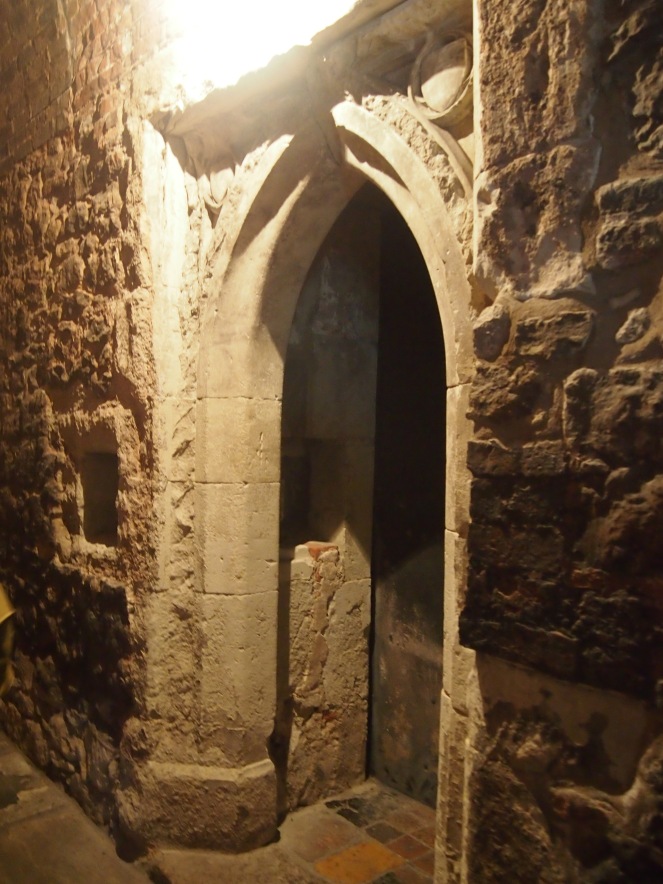
In the decades following the Reformation and the destruction of the priory, the Charterhouse buildings changed hands several times. After a few years where the former monks’ cells were rented out to a variety of tenants, Sir Edward North purchased the site and demolished parts of the old priory, building himself a grand Tudor mansion. After North’s death, the mansion was purchased by the Duke of Norfolk. He added a real tennis court, with a covered passageway linking it to the main house. This passageway can still be seen today.
However, the Duke lost favour at court and he was detained in the mansion at Charterhouse under house arrest after his involvement in the plot to put Mary, Queen of Scots on the English throne was revealed. Norfolk was accused of planning to marry Mary and the evidence that incriminated him – a letter from Mary written in code – was found at the Charterhouse. The Duke was found guilty of treason and executed in 1572.

In 1611, Thomas Sutton – thought to be the richest commoner in England at the time – purchased the site from Thomas Howard (the Duke of Norfolk’s son) and used his considerable fortune to establish “The Hospital of King James at Charterhouse”, which included a school for poor boys and almshouses for impoverished gentlemen pensioners. The school set out to educate forty boys, sometimes referred to as “poor boys” – in reality this meant boys from respectable families that would not otherwise be able to afford an education, rather than children from an extremely poor background. Today, the school is one of England’s most eminent public schools and former pupils are known as “Old Carthusians”, a nod to the Charterhouse’s original purpose as a Carthusian priory. Notable Old Carthusians include Henry Levett, who was a pioneer in the treatment of smallpox, the founder of the Methodist Church John Wesley, novelist William Makepeace Thackeray and composer Ralph Vaughan Williams.

Unfortunately for Sutton, he died very soon after the founding of Sutton’s Hospital and is buried in a magnificent tomb in the chapel on the site. He had left a large portion of his considerable wealth to his charitable foundation at the Charterhouse and some of his heirs contested this bequest, wishing to gain larger portions of Sutton’s fortune for themselves. The court ruled that Sutton’s will was valid and rejected the requests of the heirs.
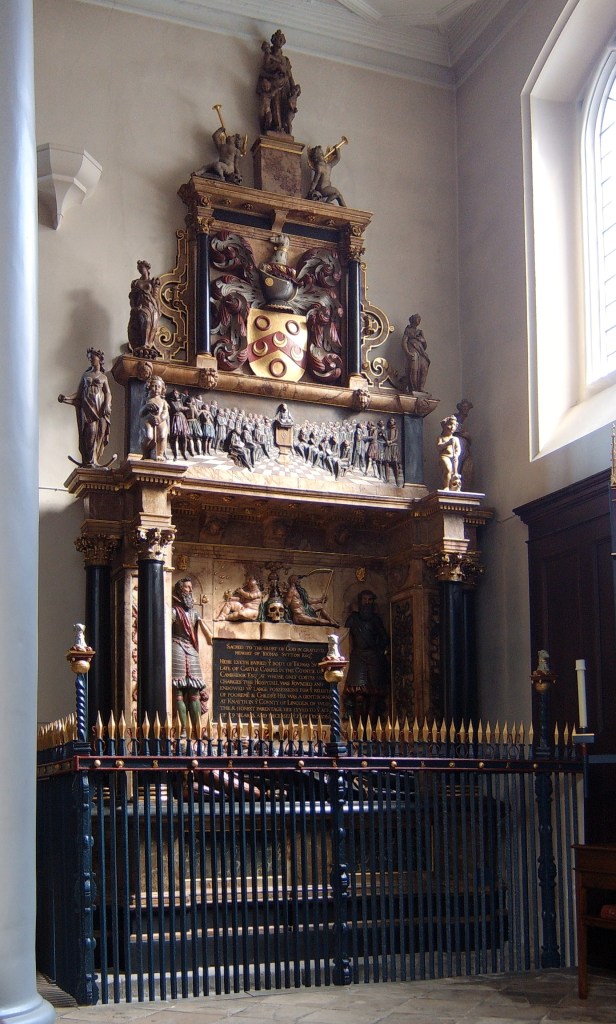
The almshouses founded by Sutton were to provide for eighty gentlemen pensioners. These men were to be gentlemen by descent who had found themselves in impoverished circumstances in old age. They might be former soldiers or sailors, former servants in the monarch’s household, or merchants who by some catastrophe had fallen on hard times. The almshouses gave the Brothers a place to live for the remainder of their lives, with the money bequeathed by Sutton paying for their upkeep.
Today, forty Brothers live at the Charterhouse, and the main criteria for admission are that the man be single, of limited means and sympathetic with the values of the Church of England. The Brothers come from a variety of backgrounds and professions, and live at the Charterhouse until the end of their lives. In recent years modern housing has been added to the site and a care home also exists for those Brothers who require extra care, either on a respite or permanent basis.
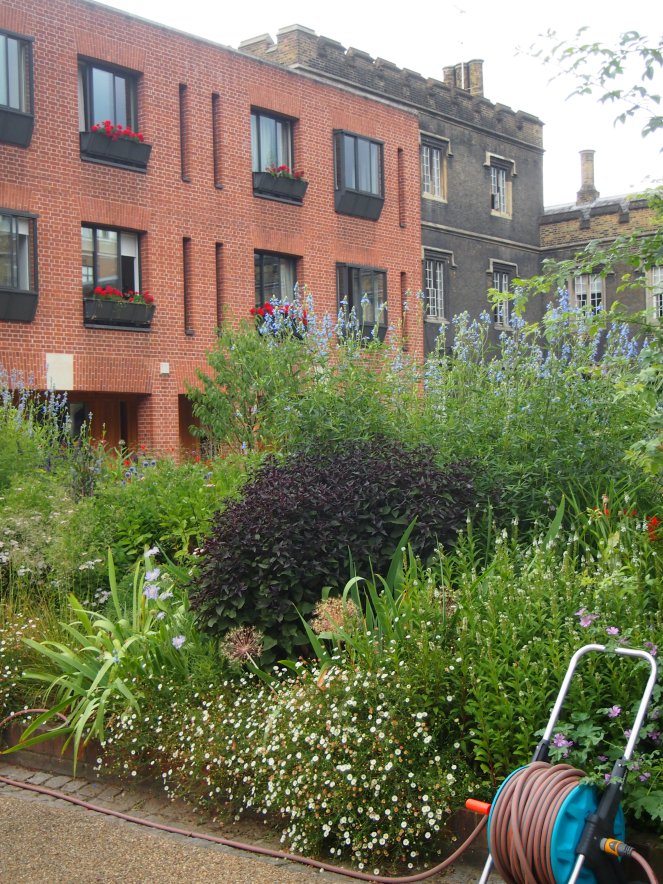
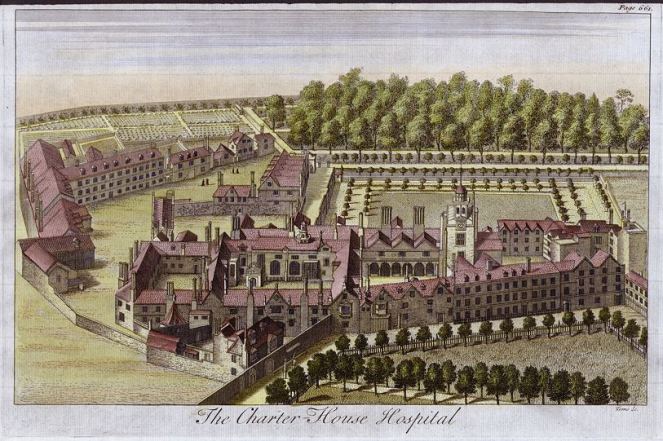
Although the priory itself is gone, a number of the medieval buildings from the time of the Carthusians still survive. Although the monks’ cells have been lost, buildings that once housed the Carthusian lay brothers are now home to some of the Brothers. Unsurprisingly, these stunning survivors are in high demand as locations for the filming of television programmes and films set in the medieval period.

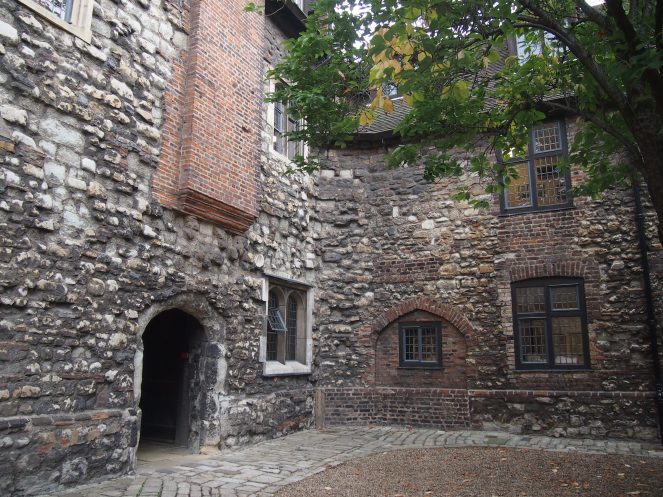
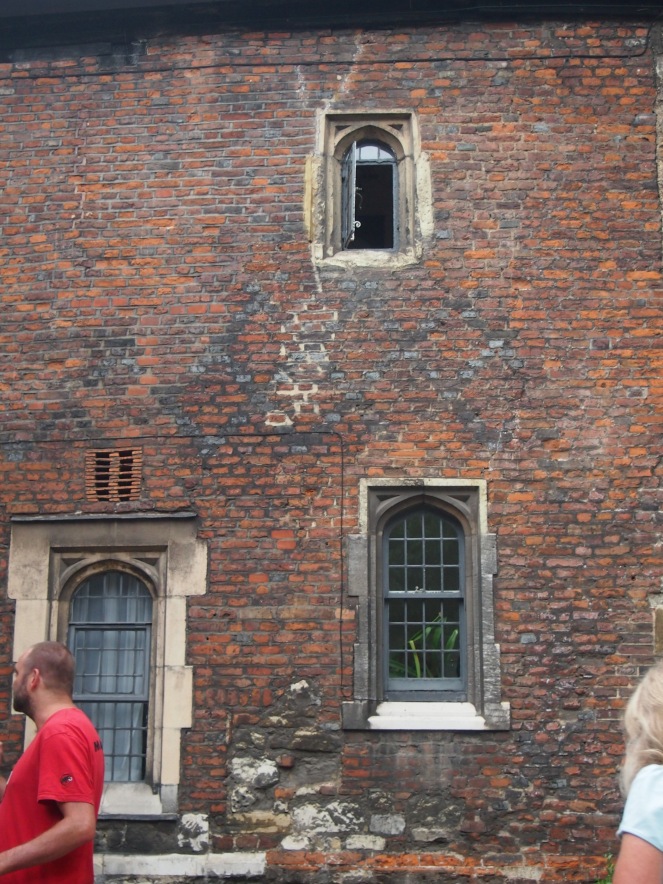
In 1872, the Charterhouse school moved to Godalming in Surrey. Clerkenwell was no longer the rural area it had once been, and had become built up – the Charterhouse complex was surrounded by slum buildings. This was not the healthiest of environments for a school, and the Headmaster at the time, William Haig Brown, successfully campaigned for the school’s removal to rural Surrey. The school remains there today, and also housed the Brothers during the height of the London Blitz.
Central London was hit hard by the air raids during the Second World War, and the Charterhouse, situated close to the utterly devastated area of Cripplegate, did not escape the destruction wrought by the Luftwaffe. On the night of 10-11 May 1941, a large swathe of the Charterhouse was destroyed by fire after an incendiary bomb fell on the site. Water pressure was particularly poor on the night of the raid and as a result, the fire caused widespread damage. The chapel, however, miraculously survived, and today the door that stopped the flames – with its bottom half burned away – is mounted proudly on the wall outside the chapel.

I will confess that prior to hearing Stephen Porter’s wonderful lecture about the Charterhouse, I had no idea that so much of the complex had been destroyed by fire during the war. This is entirely down to the incredible restoration job done by the architects Seely and Paget, who were entrusted with the mammoth task of restoring the ruined Charterhouse to its former glory. John Seely and Paul Paget were the leading conservation architects of their day and worked on a huge number of restoration projects after the Second World War. Their work at the Charterhouse in the 1940s and early 1950s enabled the complicated jumble of buildings to be sympathetically restored to their former glory – so much so, that I would never have guessed the extent of the damage sustained in the Blitz if I hadn’t have heard about the restoration.
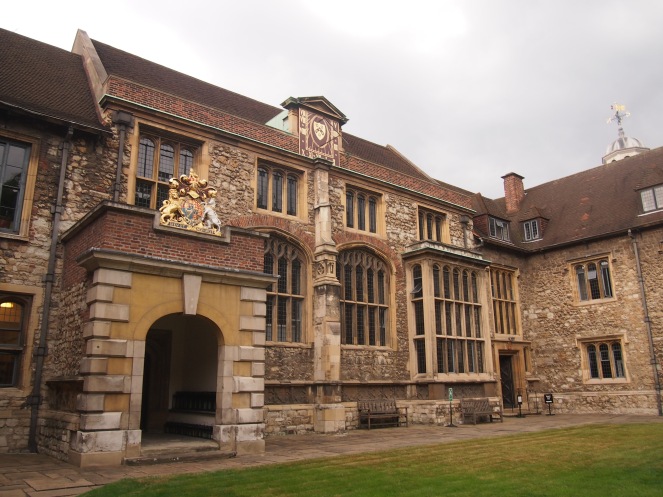

The destruction of much of the Charterhouse and the subsequent restoration work also had a fascinating impact on the understanding of the site’s archaeology. Surveying the site after the war, Seely and Paget discovered remains of the Carthusian priory that challenged previous ideas of how the site had been laid out. Remains of the old medieval building such as drains, walls and floor tiles were discovered, along with a number of windows and doors that had previously been hidden.
The history of the Charterhouse complex is still being discovered. In July, Islington Council and the Museum of London supported a Community Dig on Charterhouse Square, and I was lucky enough to be able to take part in the dig for an afternoon – my first experience of an archaeological dig. Supervised by a knowledgeable osteologist from Museum of London Archaeology (MOLA), I worked in a trench with other volunteers where we excavated a ditch that had been filled in. Artefacts found during the dig suggested that this ditch, which is thought to have marked the boundary of the plague burial ground, was filled in during the Tudor period – quite possibly after the Reformation. Most of the artefacts we excavated were building materials, such as bricks and roof tiles, and animal bones – some of which showed signs of being butchered. These butchered bones may have come from the nearby meat market at Smithfield, or may have been refuse from the Charterhouse’s flesh kitchen, which prepared meat for guests of the Carthusian monks (the monks themselves were vegetarian, so meat was not prepared within the priory’s kitchen). A few human bones were also discovered, which appeared to have been from burials that had been disturbed centuries ago and subsequently reburied.
The Charterhouse has a rich and fascinating history, more of which is being discovered all of the time. To gain a fuller picture of the site’s story, I highly recommend Stephen Porter’s book The London Charterhouse and would also encourage readers to go on a tour of the Charterhouse buildings. I found myself completely enthralled by my surroundings when I visited the Charterhouse – it has so many layers of stories and really captured my imagination. It’s a great example of an old building that continues to captivate visitors. The good news is that there are plans to open a museum on the site in the future, so that even more people can learn about a site that’s been a fascinating part of the fabric of Clerkenwell for over six hundred years.
Information about tours can be found here.
References and further reading
The London Charterhouse, Stephen Porter, Amberley Publishing, 2012
The Charterhouse – History http://www.thecharterhouse.org/history-html/
Sutton’s Hospital, Charterhouse School http://www.charterhouse.org.uk/suttonshospital
“The Charterhouse”, Old and New London vol. 2, Walter Thornbury, 1878 http://www.british-history.ac.uk/report.aspx?compid=45110
Black Death skeletons unearthed by Crossrail project, BBC News, 30th March 2014 http://www.bbc.co.uk/news/science-environment-26770334
New reserach shows Crossrail’s Charterhouse skeletons were Black Death victims, Crossrail, 30th March 2014 http://www.crossrail.co.uk/news/articles/new-research-shows-crossrails-charterhouse-skeletons-were-black-death-victims
Charterhouse Community Dig, Festival of Archaeology 2014 http://www.archaeologyfestival.org.uk/events/1487
London volunteers to join Charterhouse archaeological dig, Crossrail, 15th July 2014 http://www.crossrail.co.uk/news/articles/london-volunteers-to-join-charterhouse-archaeological-dig


Wow, so much history and such fantastic restoration work. This post is especially enlightening as I knew far less than you about the Charterhouse – many thanks for your research!
LikeLike
Thank you! I really, really enjoyed learning about the Charterhouse – my visit there was fantastic and I learned so much about a wonderful place. I can’t get over the quality of the restoration work there.
LikeLike
Great post, Caroline! I went past the Charterhouse many times when I lived in London and never got to visit – thanks for sharing your impressions!!
LikeLike
Thank you! I’m really glad I took the opportunity to visit the Charterhouse and learn more about it – I’ve worked nearby for over three years and had always wondered what was behind the wall!
LikeLike
fascinating place! thanks for writing such an informative article.
LikeLike
Thank you! I’ve really enjoyed learning about the Charterhouse – it’s a wonderful and incredibly interesting place.
LikeLike
Yes! Again, another site to the add to the list when I eventually get back down to London. Also it was nice to hear of your first archaeology dig as well – as much as I love museums, nothing quite feels as good as scraping back the soil to reveal features and artefacts that haven’t seen the light of days for centuries!
LikeLike
I *really* enjoyed taking part in the dig – archaeology’s always fascinated me but Charterhouse Square was the first time I’d had the opportunity to actually take part. It was a sweltering hot day but I enjoyed it immensely. As you say, it’s a great feeling to uncover things that have been lying hidden for hundreds of years!
LikeLiked by 1 person
Definitely, and here is hoping you get to dig again soon!
LikeLike
I was lucky enough to visit the Charterhouse on a tour in October. I agree with you it was a fascinating experience. The Tudor Great Hall was wonderful!
LikeLike
Isn’t it just a superb place? I thoroughly enjoyed my tour of the Charterhouse and would love to have another look around some time. Imagine eating all of your meals in that Great Hall!
LikeLiked by 1 person
There’s always a story behind every building.
LikeLike
So true!
LikeLiked by 1 person
🙂
LikeLike
So glad you enjoyed your visit here. Your interests make me wonder if you know of the body of work written by my pal Lucinda Hawksley? We are discussing the possibility of her writing a murder mystery based here at Charterhouse. Thanks again for your observant blog. Brother Andrew
LikeLike